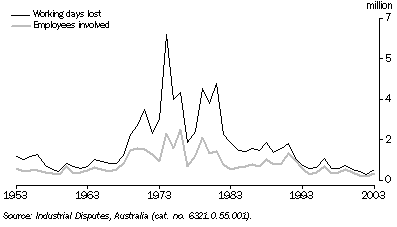Feature Article - Spotlight on Industrial Disputes
This article was published in the July 2004 issue of Australian Labour Market Statistics (cat. no. 6105.0).
INTRODUCTION
This article presents industrial disputes statistics available in the publication Industrial Disputes, Australia (cat. no. 6321.0.55.001).
BACKGROUND
In ABS statistics, an industrial dispute is a state of disagreement, over a particular issue or group of issues between an employer and its employees, that results in employees ceasing work. Industrial disputes comprise strikes, which are a withdrawal from work by a group of employees; and lockouts, which are a refusal by an employer or group of employers to permit some or all of their employees to work.
The Industrial Disputes collection includes only disputes where ten or more working days are lost. Statistics are compiled on the number of industrial disputes, working days lost and employees directly or indirectly involved in industrial disputes. Information is also available about the Cause of Dispute and Reason Work Resumed. The data are used in analysing and monitoring industrial disputation in Australia.
INDUSTRIAL DISPUTES STATISTICS
The number of working days lost per year, and the number of employees involved, have demonstrated a noticeably downward trend over the last two decades (as shown in graph 1), although there have been short-term increases in some periods.
Graph 1, Industrial disputes, Working days lost - number of employees

Table 1 shows that 439,400 working days were lost in 2003, an increase of 70% over 2002. While the number of working days lost increased, the number of industrial disputes declined in 2003 - reflecting an increase in the relative size of disputes in 2003, in terms of the length of the dispute or the number of employees involved. The average number of working days lost per dispute in 2003 was 684, more than double that in 2002 (338).
Table 1, Industrial disputes |
|  |
 |  | 1998 | 1999 | 2000 | 2001 | 2002 | 2003 |  |
|  |
| Working days lost | '000 | 526.3 | 650.8 | 469.1 | 393.1 | 259.0 | 439.4 |  |
| Disputes | no. | 520 | 731 | 700 | 675 | 767 | 643 |  |
| Employees involved | '000 | 348.4 | 461.2 | 325.4 | 225.7 | 159.7 | 275.6 |  |
| Working days lost per dispute | no. | 1,014 | 890 | 672 | 582 | 338 | 684 |  |
|  |
| Source: Industrial Disputes, Australia (cat. no. 6321.0.55.001), spreadsheet table 1. |
INDUSTRY
The number of working days lost per thousand employees has fluctuated over the last five years, varying from a high of 87 in 1999 to 32 in 2002 (see Table 2). In 2003, there were 53 working days lost per thousand employees. Of the industries shown, Coal mining had the highest number of working days lost per thousand employees in each year between 1998 and 2003, although the figure for 2003 (356) was considerably less than the number in 1998 (2,732). Other industries with a relatively high number of working days lost per thousand employees in 2003 were: Mining other than coal (323), Construction (249) and Metal product; machinery and equipment manufacturing (202).
Table 2, Working days lost per 1,000 employees(a) |
|  |
 |  | 1998 | 1999 | 2000 | 2001 | 2002 | 2003 |  |
| Industry | '000 | '000 | '000 | '000 | '000 | '000 |  |
|  |
| Mining |  |  |  |  |  |  |  |
 | Coal | 2,723 | 1,445 | 1,933 | 956 | 357 | 356 |  |
 | Other | 23 | 35 | 60 | 33 | 20 | 323 |  |
| Manufacturing |  |  |  |  |  |  |  |
 | Metal products; Machinery and equipment | 71 | 282 | 170 | 258 | 88 | 202 |  |
 | Other | 106 | 120 | 121 | 148 | 83 | 59 |  |
| Construction | 524 | 381 | 234 | 275 | 220 | 249 |  |
| Transport and storage; Communication services | 114 | 42 | 52 | 27 | 37 | 37 |  |
| Education; Health and community services | 57 | 165 | 79 | 8 | 3 | 85 |  |
| Other industries(b) | 7 | 7 | 9 | 7 | 9 | 5 |  |
| All industries | 72 | 87 | 61 | 50 | 32 | 53 |  |
|  |
| (a) Classified according to the Australian and New Zealand Standard Industrial Classification. |
| (b) Includes: Agriculture, forestry and fishing; Electricity, gas and water supply; Wholesale trade; Retail trade; Accommodation, cafes and restaurants; Finance and insurance; Property and business services; Government administration and defence; Cultural and recreational services; and Personal and other services. |
| Source: Industrial Disputes, Australia (cat. no. 6321.0.55.001). |
CHANGES TO DISSEMINATION OF INDUSTRIAL DISPUTES STATISTICS
The December 2003 issue of Industrial Disputes, Australia (cat. no. 6321.0), which was released on 19 March 2004, was the final monthly release in the form of a printed publication. A number of changes to the release of statistics on industrial disputes were introduced with the release of Industrial Disputes, Australia (Electronic Publication) (cat. no. 6321.0.55.001) for the March quarter 2004 on 17 June 2004. These changes included:
- presenting statistics on industrial disputes for quarterly reference periods (rather than monthly)
- releasing an electronic-only publication
- introducing new classifications for Cause of Dispute (which identifies whether disputes occurred during a process of enterprise bargaining), and Reason Work Resumed (formerly called Method of Settlement), and
- changing the format of electronic time series spreadsheets from Lotus 1-2-3 WKS to Microsoft Excel.
FURTHER INFORMATION
For further information about statistics on industrial disputes, contact the Manager, Industrial Disputes on Perth 08 9360 5159.
For email enquiries, please contact Client Services on client.services@abs.gov.au.
 Print Page
Print Page
 Print All
Print All